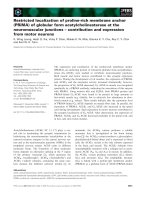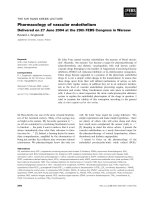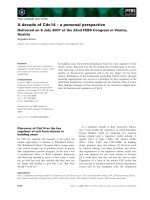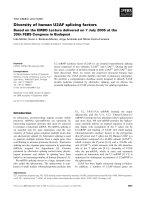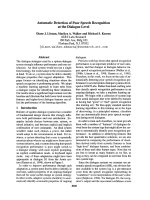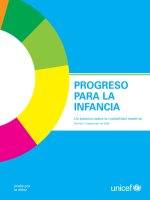Algorithm of intestinal parasites found at the abass NDAO Hospital in Dakar
Bạn đang xem bản rút gọn của tài liệu. Xem và tải ngay bản đầy đủ của tài liệu tại đây (158.51 KB, 7 trang )
Int.J.Curr.Microbiol.App.Sci (2019) 8(6): 428-434
International Journal of Current Microbiology and Applied Sciences
ISSN: 2319-7706 Volume 8 Number 06 (2019)
Journal homepage:
Original Research Article
/>
Algorithm of Intestinal Parasites Found at the
Abass NDAO Hospital in Dakar
Pathé Thiongane1, Amadou Ndiaye1*, Arfang Diamanka3, Cheikhna Diebakhate3,
France-Lyse Clotilde Ba3, Moustapha Diagne3, Ngor Faye3,
Pape Mbacké Sembene3 and Niama Diop Sall1,2
1
Abass NDAO Hospital, Department of Laboratories, Avenue Cheikh Anta Diop framed
between road Fann, the Road 50 and 67 of the Medina
2
Faculty of Medicine, Pharmacy and Dentistry (FMPOS) in Dakar, Laboratory of Medical
Biochemistry, UCAD
3
Faculty of Science and Technology, Department of Animal Biology, Dakar - Senegal
*Corresponding author
ABSTRACT
Keywords
Abass NDAO
Hospital, MCBA,
prevalence,
parasites, Stool and
Ritchie's method
Article Info
Accepted:
04 May 2019
Available Online:
10 June 2019
In Senegal, an efficient and effective struggle against intestinal parasites and there, their
affections (bordering 40 % of the global nature of the tropical diseases other than the
malaria especially in the African regions), requires essentially a good knowledge on one
hand of their frequencies and geographical distributions, and on the other hand of their
assessments and epidemiological distributions, and on the other hand of their assessments
and epidemiological evolutions. It is from this perspective; a study was led to Medical
Center of Biology Analysis (MCBA) at Abass NDAO Hospital in Dakar during the first
nine months of 2013. During this period every sample of stools underwent a macroscopic
exam followed of the microscopic exam (each stool sample underwent a macroscopic
examination followed by a direct microscopic examination and after concentration
according to Ritchie's method). At the end of study, the exploitation of the data emanating
from 125 patients got the following results: An overall prevalence of 16, 8%. Variation of
the parasitic carriage according to different parameters (month, age, sex, consistency of the
stool and reason for diagnosis). Specific parasitic prevalences with 10,4% for Entamoeba
coli;2,4% for Trichomonas intestinalis or Ascaris lumbricoides and 0,8 % for Entamoeba
histolytica, Trichuris trichiura ,Strongyloides stercoralis ,Hymenolepis nana or Taenia sp;.
Prevalence of the poly parasitism is 1, 6% and an ascendancy of protozooses with a
prevalence of 13,6 % against 5,6 % for helminthiasis.
adequate sanitary facilities and climatic
conditions; the parasitological parasites,
thanks to the parasitological examination of
human stools, constitute a veritable sanitary
haven for people. Because of their presence in
the human digestive tract, their proliferation
Introduction
Due to their medical conditions and
cosmopolitanism, which in certain parts of the
world are favored by circumstances such as
lack of hygiene and sanitation, lack of
428
Int.J.Curr.Microbiol.App.Sci (2019) 8(6): 428-434
and their future location, many of these
parasites are subject to either simple
asymptomatic portages or portages subject to
considerable clinical manifestations. These
intestinal parasites potentially belong to two
systematic groups, Helminths and Protozoa
(Rousset JJ, 1993).
frequency
of
parasite
species
and
associations, and to evaluate parasite
prevalence according to different parameters.
The WHO estimates that more than 2 billion
people in the world are affected by these
parasites, 300 million people, seriously ill
people, and 155,000 deaths a year due to
these parasitic infections.. Especially in the
tropics, these diseases are medically
important because they account for nearly
40% of tropical diseases other than malaria.
Remarkably, these parasitic diseases are
found for the most part in African regions
(WHO, 2012)
We used various types
materials and consumables:
Materials and Methods
Material
of
equipment,
During sampling: transparent plastic pots that
can be closed hermetically; plaster and
marker for the labeling of sampling vessels;
During direct examination (fresh state and
color): disposable gloves; agitator stick;
physiological water and needle syringe; lugol
1% (dropper system); slides and lamellae of
histology; black pencil and photonic
microscope.
Senegal, a country with a tropical climate
that, in addition to the habits and lifestyles of
its people, combines all the physical and
geographical elements (temperature, climate,
rainfall, vegetation, sunshine and altitude)
conducive to
the
maintenance and
proliferation of parasites intestinal, is not
spared the harmful impact of their affections
and is a great home for them.
In enrichment or concentration technique
(Ritchie method): glass rod to collect a
portion of stool; footed glass helping to crush
hard stools; plastic pots; gauze band ensuring
sieving (obtaining the filtrate); 10% formalin
solution as an aqueous dilution solution;
graduated tubes with a conical bottom
collecting the filtrate to be centrifuged; Ether;
centrifuge; Pasteur pipettes; disposable
gloves; slides and lamellae of histology; black
pencil and photonic microscope. Freshly
made saddles
Also, an efficient and effective fight against
these parasites and thus their affections
requires primarily a good knowledge on the
one hand of their frequencies and
geographical distributions and on the other
hand
of
their
distributions
and
epidemiological evolutions. Having this
information requires the relevance and
permanence of the surveillance system
through descriptive investigations. It is in this
context that we conducted a study over a
period of nine months (January to September
2013) at the Center for Analysis in Medical
Biology (CABM) of the Abass Ndao Hospital
Center (CHAN); in order to determine the
overall prevalence of parasites, to estimate the
Study methods
Each sample underwent
examination followed by
examination.
macroscopic
microscopic
Macroscopic examination
Visually, gross examination consists of
detecting the consistency of the stool; the
presence of mucus, mucus and / or blood and
429
Int.J.Curr.Microbiol.App.Sci (2019) 8(6): 428-434
the possible presence of adult worms or
cestode rings.
add 3 ml of ether. The mixture is vigorously
agitated to become homogeneous before
centrifuging at 1500 rpm for three (3)
minutes. The tube will comprise, after
centrifugation, four (4) layers whose three
upper layers are to be eliminated by sudden
reversal of the conical tube. The pellet is
recovered using a Pasteur pipette and
examined directly under the optical
microscope between blade and coverslip to
the objective X10 and then to the objective
X40. If necessary, a drop of saline is added to
the pellet.
Microscopic examination
Microscopic examination involves a direct
examination and a post-concentration
examination according Ritchie method
Direct examination in the fresh state and
after staining
This first part of the microscopic examination
is as follows: a drop of saline is deposited in
the center of the upper half of the slide and a
drop of the lugol solution in the center of the
lower half (the portion of the slide serving
number the microscopic preparation being
considered the lower end). By means of an
applicator stick, a small portion of saddle is
taken and mixed well with the drop of saline
solution. In the same way, a small portion of
sample is taken and mixed with the drop of
the iodine-iodide solution (1% lugol). The
mixtures obtained are covered with respective
lamellae. The whole of the preparation thus
carried out is observed under a light
microscope first at the X10 objective for the
identification and then at the X40 objective
for the identification.
Post-Concentration
ritchie method
review:
Results and Discussion
Following these
two
categories
of
examinations (macroscopic and microscopic),
different information was obtained. These
data were entered on a computer and
processed using the Excel spreadsheet. The
khi2 test under MegaStat, allowed us to
compare the results relative to the different
variables, the p-value lower than 0.05 being
considered statistically significant.
Presentation of the results
Of the 125 patients, 21 are carriers of one or
more parasites, an overall parasite carrying
prevalence of 16.8%. Seven (7) male subjects
are parasitized with a male prevalence of
13.21%, and fourteen (14) female subjects is a
female prevalence of 19.44%. The chi-square
test reveals that both characters (parasitism
and sex) are statistically independent. p-value
= 0.3567> 0.05; ddl = 1.
modified
This physic-chemical enrichment technique is
concretized by proceeding as follows: about 2
to 5 g of stool are taken from several points of
the sample in order to gradually dilute them
using a glass stirrer in a solution of 10%
formalin (in a proportion of 1 g of stool per
10 ml of formolated water). The preparation is
allowed to stand for a maximum of one
minute (decanting large particles) before
sieving through a suitably folded gauze band.
9 ml of the liquid obtained is transferred into
a graduated conical bottom tube in order to
The monthly parasitic prevalences are
reported in Figure 1, that of July (36.84%)
being the most consistent.
Presentation of the results
Of the 125 patients, 21 are carriers of one or
more parasites, an overall parasite carrying
430
Int.J.Curr.Microbiol.App.Sci (2019) 8(6): 428-434
prevalence of 16.8%. Seven (7) male subjects
are parasitized with a male prevalence of
13.21%, and fourteen (14) female subjects is a
female prevalence of 19.44%. The chi-square
test reveals that both characters (parasitism
and sex) are statistically independent. p-value
= 0.3567> 0.05; ddl = 1.
Entamoeba coli (vegetative and / or cystic)
found in 13 individuals, a prevalence of
10.4% (Figure 2). In the case of systematic
groups, helminths were recorded in 7
individuals,
with
a
prevalence
of
helminthiases of 5.60% and protozoa in 17
individuals, ie a prevalence of protozooses of
13.60%. However, two types of associations
parasites were found: a case of biparasitism
(prevalence equal to 0.8%) with S. stercoralis
and H. nana; and a triparasitism case
(prevalence equal to 0.8%) with A.
lumbricoides, T. trichiura and E. coli.
The monthly parasitic prevalences are
reported in Figure 1, that of July (36.84%)
being the most consistent.
Eight species were identified, including
Fig.1 Monthly parasitic prevalences
Fig.2 Prevalence of species encountered
431
Int.J.Curr.Microbiol.App.Sci (2019) 8(6): 428-434
Fig.3 Prevalence of age cohorts
Fig.4 Prevalence according to the reason of prior diagnosis
The infestation rate is higher in the age group
[30 to 45 years [24.14% (Figure 3). Age and
parasitic carriage are, however, statistically
independent (p-value = 0.7549 and dof = 4). It
appears that the parasite prevalence is 15.38%
in individuals seeking a parasitological
assessment and also 15.38% in subjects with
GEA (Figure 4). Similarly, the diagnostic
pattern and the parasitic carriage are
statistically independent (p-value = 0.7097
and ddl = 4).
C.,
2012).
Similarly,
investigations
concerning other areas of Senegal (Diongue
O., 2001 and Gueye C., 2006) or other areas
(Carvalo-Costa FA et al., 2007 and Nanfah
WMP, 2008) have rates higher than the one
we just found. On the other hand, it is higher
than recently reported rates (Amine et al.,
2008 and Ndayo, 2011).
Our prevalence, like the others, is essentially
a matter of hygiene versatility, the lack of
health information and education, and the
quality and way of life of the population.
Their difference is explained on the one hand
by the nature of the copro-parasitological
The infestation rate estimated at 16.8% has
just reached rates already recorded in the
Dakar region (Ndiaye A., 2006 and Seck M.
432
Int.J.Curr.Microbiol.App.Sci (2019) 8(6): 428-434
research techniques and on the other hand by
the characteristics of the sample. Indeed, the
infestation rate we found is slightly higher
than that found at Khelcom (Thiam M.,
1999), using only the direct examination.
their activities (garrotes, housewives, etc.),
female subjects could be the most exposed to
contamination. Also, individuals aged 15 to
60 years are the most parasitized with 20%
for [15 to 30 years [, 24.14% for [30 to 45
years [and 23.08% for [45 to 60 years [. These
people
(pupils,
garbage
collectors,
shopkeepers, garrote customers, etc.) could
also be the most exposed to insalubrity,
especially in urban areas.
Intestinal protozooses predominate in our
study with a prevalence of 13.60% against
5.60% for helminthiases. Indeed, the
detection of most protozoa (undoubtedly
associated with transmission by drinks, hands
or contaminated food) by standard techniques,
contributes to this finding. Also, a suspicion
of intestinal parasitosis generally elicits the
use
of
antihelminthics
and
health
organizations or actors work repeatedly
against helminthiases. In Senegal, under the
direction of the Ministry of Health, a
deworming campaign is aimed at children
aged 0 to 5 years, and soil-transmitted
helminthiasis (considered as neglected
tropical diseases) are at the origin of free
chemo prevention.
Parasite prevalence appears to be higher in
patients with diarrhea (27.78%) and those
with abdominal pain (20%). This is because
diarrhea and abdominal pain characterize
intestinal disorders caused by intestinal
parasites and are not medically taken lightly.
Also, the parasite prevalence followed a
monthly fluctuation being more important in
the months of July (36.84%), April (28.57%)
and May (23.81%)., during the wet season,
are more suitable for the maintenance and
transmission of intestinal parasites (hence
remarkable prevalences noted in August
(18.75%) and September (11.76%)). Senegal
is indeed a country with a tropical climate
characterized by a short wet season (July to
October).
Of the protozoa encountered in our study, E.
coli has the highest prevalence rate of 10.4%.
This emanates from the fact that this nonpathogenic parasite, contaminated by hygienic
failures, is naturally identified through its
vegetative and / or cystic form. Helminthic
species, A. lumbricoides predominates with a
prevalence of 2.4%. The other species found
Taenia sp, H. nana, S. stercoralis and T.
trichiura each have a prevalence of 0.8%. The
weakness of these prevalences relative to
these different helminths reflects particularly
the support that can emanate from certain
specific research techniques (especially Kato
and Bailenger) and the positive impact that
some actions (sensitization and deworming
campaign) could have on these parasites.
Characteristically, our sample comprises in a
large majority of individuals suggesting a
parasitological balance (41.6%).
It is concluded at the end of our study, that the
rate of infestation by intestinal parasites
remains significant in the Senegalese capital.
It would be interesting to compare the type of
parasitic disease according to the source, the
use or not of antiparasitic agents for
preventive purposes and dietary habits. This
would correlatively allow the data obtained,
to initiate better therapeutic pest coverage.
References
Amine M., Zougaghi L., El houdzi J. and
Adarmouch L., 2008. Epidemiology of
intestinal parasitic infections in
children. Medical Expectation, Vol.15,
No. 152, 477-482.
There was a female infestation rate of 19.44%
against 13.21% for the male one. Indeed, by
433
Int.J.Curr.Microbiol.App.Sci (2019) 8(6): 428-434
Carvalo-Costa F. A., Gonçalves A.Q. and
Lassance S.L., 2007. Giardia lamblia
and other intestinal parasitic infections
and their relationships with nutritional
status in Brazilian Amazon. Revista
do Instituto de Medicina Tropical Sao
Paulo. Vol.49, No. 3, 147-153.
Diongue O., 2001. Qualitative and
quantitative
evaluation
of
parasitological examinations carried
out in the laboratory of the Fatick
health center from 1996 to 2000.
Thesis Pharmacy. Dakar, No. 78, 73p.
Gueye C., 2006. Study of intestinal parasitosis
detected at Amadou Sakhir Mbaye
Hospital of Louga during the period
2004-2005.Thèse Pharmacie.Dakar, N
° 47,54-57.
Nanfah W.M.P., 2008. Study of intestinal
polyparasitism at INRSP in the district
of Bamako-Mali. Thesis Pharmacy.
Bamako, 106p.
Ndayo S.V.G., 2011. Intestinal parasitic
carriage in children in Africa. Thesis
Pharmacy. Lille: University of Lille 2,
106p.
Ndiaye A., 2006. Contribution to the study of
intestinal parasitosis at the Institute of
Social
Pediatrics
of
PikineGuédiawaye. Thesis Pharmacy. Dakar,
No. 3, 60-63.
Rousset J-J., 1993. Practical Coproparasitology:
Interest
and
Methodology - Notions on digestive
tract parasites. Paris: ESTEM, 89
pages, ISBN 2-909455-15-7.
Seck M. C., 2012. Study of the prevalence of
intestinal parasitosis in the commune
of Dalifort (Department of Dakar,
Senegal). Thesis, Pharmacy. Dakar, N
° 93, 75 pages
Thiam M., 1999. Prevalence of endemic
parasitic diseases in the Khelcom area
(Gossas department, Fatick region) Results obtained in Touba-khelcom
(Quranic School No. 9). Thesis
Pharmacy. Dakar, No. 74, 49-63.
WHO, 2012. Helminthiasis Control in
School-Age Children: A Guide for
Program
Managers.
2eédition.
Geneva: WHO Publishing, 75p.
How to cite this article:
Pathé Thiongane, Amadou Ndiaye, Arfang Diamanka, Cheikhna Diebakhate, France-Lyse
Clotilde Ba, Moustapha Diagne, Ngor Faye, Pape Mbacké Sembene and Niama Diop Sall.
2019. Algorithm of Intestinal Parasites Found at the Abass NDAO Hospital in Dakar.
Int.J.Curr.Microbiol.App.Sci. 8(06): 428-434. doi: />
434


